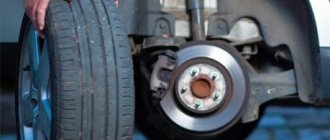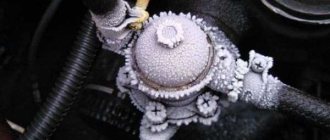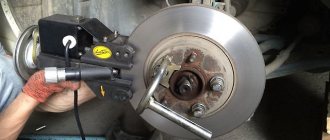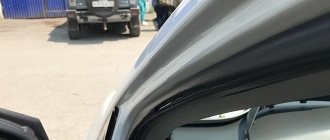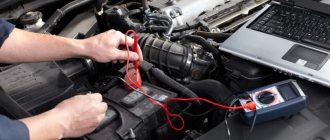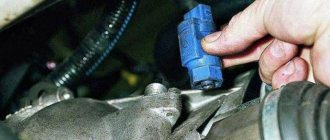Legal advice > Administrative law > Road accidents, traffic police, traffic rules > U-turn at a one-way intersection: main characteristics and limitations
The turning maneuver, including at one-way intersections, is considered a relatively difficult situation on the road, especially in urban environments. How to correctly perform such a maneuver, what measures should be taken for its safe start and completion, and also what penalties may be for traffic violations will be discussed in this article.
Traffic rules: what is a U-turn?
The traffic rules of the Russian Federation regulate the situation of a U-turn in paragraphs 8.1-8.10. These rules do not provide a precise definition of what a reversal is. According to the meaning and interpretation of this regulatory document, a U-turn should be considered a traffic movement associated with a change in the direction of movement. This can be a change to the opposite direction, either in a lane or in the lane of another road. Moreover, such changes in the direction of movement are associated with the passage of oncoming traffic, moving cars along the road crossing the intersection.
Ways to turn around at a one-way intersection
There are two main options for making a reversal.
The first option is the simplest and safest - to take the extreme right position in your lane, wait until there is free space from traffic at the intersection and perform a U-turn maneuver from your starting point, practically without stopping. This option works well with relatively low-intensity vehicle traffic.
The second option is to make a U-turn into the intersection, allow oncoming traffic to pass, and complete the U-turn. This maneuver is recommended to be performed only if there is sufficient space at the intersection itself. This is necessary in order not to interfere with passing, bypassing and oncoming traffic from the intersecting road.
Dividing strip
At a number of intersections there are dividing strips or so-called “braking lanes”. In accordance with traffic rules clause 8.10. If there is a median or braking lane, the driver intending to turn or turn around must change lanes in a timely manner and reduce speed only in this lane.
If there is a braking lane at the entrance to the road, the driver must move along it and change lanes into the adjacent lane, giving way to vehicles moving along this road.
In this situation, the driver can enter the braking lanes or median and wait for a favorable moment from the traffic of the intersecting road in order to complete the U-turn maneuver.
Types of punishable U-turns
The traffic rules say that a turn must be carried out so that during the maneuver the vehicle (vehicle) does not end up in the lane of oncoming traffic (Article 8.6 of the traffic rules). Sections of the road where you cannot turn around are prescribed in Art. 8.11.
It is prohibited to turn the car:
- at a pedestrian crossing;
- in a car tunnel;
- at the railway crossing site;
- on a road running along a bridge, overpass, overpass and under these structures;
- on sections of the road where the viewing area is less than 100 m;
- at public transport stops;
- on all sections of the roadway where there are markings in the form of a solid or double solid line.
Let us consider each of these dispositions in more detail from the point of view of traffic rules and the Code of Administrative Offenses of the Russian Federation.
U-turn at a pedestrian crossing
This maneuver is prohibited both on the crossing markings and with a short approach to it. That is, you can neither start a turn maneuver nor finish it if there is a possibility of “stepping” on pedestrian markings.
The fine for such a violation is 2 thousand rubles (Article 12.15, paragraph 2 of the Code of Administrative Offenses of the Russian Federation). To collect a fine, the offense must be recorded by a traffic police inspector or special recording equipment.
U-turn in the tunnel
Tunnels are indicated by a special road sign with a schematic image of the tunnel. This section of the road is characterized by reduced visibility due to the use of artificial lighting and a small free area for maneuvers. Therefore, turning around in the tunnel is prohibited. As a rule, an additional sign prohibiting a turn is a solid or double solid marking line demarcating lanes.
A U-turn in a tunnel is punishable by a fine of 1 thousand to 1.5 thousand rubles. (Article 12.16, paragraph 2 of the Administrative Code). As a rule, this violation is recorded using automatic means of recording.
U-turn at a railway crossing
A railway crossing is a section of a high-risk road. The crossing area is indicated by signs with a schematic image of a railway track or locomotive. Traffic regulations prohibit turning around at a crossing; therefore, turning around is prohibited not only on railway tracks, but also on the adjacent road surface. For turning around at a crossing, according to Art. 12.14, clause 2 of the Code of Administrative Offences, a fine of 500 rubles is imposed.
U-turn at a public transport stop
A shuttle bus stop is a section of the roadway specially designated for boarding and disembarking passengers. The allocation of a place to stop on the road is carried out constructively (by widening the road surface and applying special markings) and (or) with a “Stop” sign.
This section of the road is dangerous due to heavy pedestrian traffic. Therefore, you cannot turn around in this area. If there are no prohibiting markings, then you can turn around next to the stop, that is, in the lane located to the left of it. For violation of this rule, a fine of 500 rubles is provided. (Article 12.14, paragraph 2 of the Administrative Code).
It is worth noting that the traffic police reduces the fine by exactly half if the driver at fault pays it within 20 days from the date of the offense. This relief does not apply to drivers who have committed the same offense several times during the year.
Driver actions before turning
Before starting to make a U-turn at a one-way intersection, the driver must complete a number of preparatory measures.
- firstly, take the extreme right position in your lane of the roadway, closer to the side of the road, immediately before the start of the intersection.
- Secondly. turn on your turn signal to warn other drivers of your intentions
- thirdly, make sure that the start of the maneuver will not interfere with passing traffic
- mark the starting point for the turn
- start the maneuver.
Topic 8.4. Start of movement. Maneuvering. U-turns
Turning around can be a difficult and dangerous maneuver if you don't take into account a number of factors. Let's look at some of them.
Rules for turning at intersections
largely coincide with the rules for left turns, which we discussed in the previous chapter.
To make a turn, you must turn on the left turn signal.
, having previously taken
the extreme left position on the roadway
. If there are rails to your left, and they do not stick out from the asphalt “like an iceberg in the ocean” (that is, they are at the same level as the roadway), then you need to make a U-turn from them.
Moreover, if signs or markings defining the direction of movement along the lanes allow a left turn from several lanes, the turn must still be made only from the far left lane.
However, driving onto the rails is no longer allowed.
But what trajectory
will be made
,
the Rules are silent.
If you want, turn around a small radius, or if you want, turn around a large one. The main thing is that when leaving the intersection of roadways, the vehicle does not end up on the side of oncoming traffic.
And although the Rules do not object to using one or another option, traffic police inspectors often stop drivers who decide to shorten the circle by turning around before reaching the center of the intersection. And you have to defend your innocence in court.
But if one of the roads being crossed has a dividing strip, then a U-turn is only permissible along a long trajectory.
Otherwise, the driver, moving along a small radius, will make a left turn before making a U-turn, and when leaving the first intersection of roadways, he will find himself on the side of oncoming traffic. And accordingly, it will fall under clause 8.6 of the traffic rules, violation of which is punishable by a large fine or even deprivation of rights for up to six months.
Teachers of the driving school HIVE! We prepared a short video where they showed making a U-turn at an intersection with a dividing strip, which obviously does not violate clause 8.6 in any of its interpretations.
When completing the turn, you can safely enter any free lane.
Separately, it is worth mentioning a U-turn at an intersection when the road being crossed is one-way
.
Problems on this topic are found in the theoretical exam.
The training vehicle needs to turn around. This, of course, could have been done outside the intersection, if not for the continuous markings separating oncoming traffic. And now, hurray! The long-awaited gap at the intersection of roads. But one of them is one-sided. How to be?
A U-turn at a one-way intersection is not prohibited. Moreover, you can perform it along any trajectory, and the traffic police inspector will not say a word to you. Because when leaving an intersection of roadways, you do not drive onto the side of oncoming traffic. There is nothing to complain about here. Unless it means that you did not let other vehicles pass on your road, violating clause 8.1 of the traffic rules.
There are far fewer requirements for turning around outside an intersection.
In the same way, before turning, you must take the extreme left position on the roadway. And if there are tram tracks on the left at the same level, then the maneuver is performed from the rails.
However, if the roadway is narrow, and your car is huge and may end up in a ditch when turning, then you can turn between intersections from the right lane or even from the side of the road if the width of the roadway is not enough for you.
In this case, the driver is obliged to let both oncoming and passing vehicles pass.
Keep in mind: if the width of the roadway allows you to make a U-turn from the left lane, then you cannot make a U-turn from the right lane.
If there are adjacent territories, you can make a U-turn with their help. But at the same time, the rule “give way to all vehicles, passing and oncoming” continues to apply in this case.
"The forbidden fruit is always sweet." This saying does not apply to reversals
.
Indeed, in places where
this maneuver is prohibited
Below we list the places where the Rules prohibit a U-turn.
At pedestrian crossings
. Traffic police officers joke: for crossing about ten solid lines at once (meaning a zebra crossing), you will have to pay a fine before retirement.
But we are talking specifically about the pedestrian crossing itself. But before and after it, please turn around.
In the tunnels
. Everything here is so obvious that you don’t even need to read the traffic rules.
On and under bridges, overpasses, overpasses
. If you don't want to fall into the river, for example.
At railway crossings
. A loaded train traveling at a speed of 80 km/h will be able to stop only a kilometer (!) after the start of braking. Moreover, regardless of whether your car has stopped on the rails or is just starting to turn around 
Again: turning around is prohibited precisely at a railway crossing. But before that it is not prohibited. Therefore, if you are tired of waiting for the trains to stop flashing before your eyes, turn around and look for detours.
In places where visibility of the road in at least one direction is less than 100 meters
.
Visibility should be more than 100 meters in both directions
. Because if at least one of them is not 100 meters, then turning around is prohibited.
In places where route vehicles stop.
Moreover, you need to pay attention not only to your side of the road, but also to the oncoming side. Even during the traffic police exam, a violator can be caught doing this.
Are you allowed to make a U-turn at this location?
1. Allowed. 2. Permitted if it does not interfere with the movement of route vehicles. 3. Prohibited.
Although the stop for route vehicles is located on the left side and they even widened the road for it, this does not change anything. The traffic rules clearly state that turning around is prohibited in this place. The correct answer is 3.
U-turn technique
The general rules for performing a U-turn, including performing this maneuver at one-way intersections, are regulated by clause 8.5 of the Russian Traffic Regulations. In particular, the driver must adhere to the following techniques to safely perform this maneuver.
- We occupy the extreme left position on the roadway if we intend to turn right, and the extreme right position if we intend to turn left. This is necessary in order to have sufficient space for maneuver. If the width of the roadway is sufficient not to interfere with other vehicles, then you can perform the maneuver directly from the center of the roadway.
- We make sure that with our maneuver we do not create obstacles for transport traveling in the same direction.
- We turn on the turn signal in advance, indicating our intention to turn right or left.
- We expect that we will not completely interfere with the movement of passing traffic on our part of the road and will allow vehicles traveling along the other road of the intersection to pass.
- As soon as there is no traffic interfering with us on the crossing road, we drive out to the intersection and quickly complete the turning maneuver.
- If, at the moment of entering the intersection, a car appeared on the intersecting road, i.e. obstacle, then having this object of movement on the right, we let it pass and then complete our maneuver.
When performing such a maneuver, you should not rush. It is best to wait until there is a sufficient window of time in traffic on the intersecting road at the intersection in order to safely complete the U-turn maneuver. In a normal traffic situation, the turning maneuver takes no more than 10 -15 seconds.
In the situation of making a U-turn at an intersection, special cases may occur.
These are situations such as:
- For heavy vehicles or trailers - long vehicles may require more space to make a turn. In this situation, the driver of such a large vehicle can make a U-turn from the very right edge of the road or even its shoulder. Such a maneuver can only be carried out if all road participants are given advance warning of the intention using turn signals.
- in cases where at the intersection where it is supposed to perform a U-turn maneuver, there are no signs indicating the priority of traffic participants, the right of turn, then the maneuver is performed with the obligatory passage of all moving cars located on the right side.
When making a maneuver at an intersection, including one-way traffic, you must always let pedestrians pass at the place of the pedestrian crossing indicated by the appropriate traffic signs.
Are you allowed to make a U-turn on this section of the road?
Correct answer: Allowed only when road visibility is at least 100 m.
Ticket 13 - Question 10
At what maximum speed do you have the right to continue driving a car?
Correct answer: 90 km/h.
Ticket 13 - Question 11
How many vehicles can you overtake at the same time after passing through a pedestrian crossing?
Correct answer: All three.
Ticket 13 - Question 12
Are you allowed to stop on the bridge to pick up a passenger?
Correct answer: Prohibited.
Ticket 13 - Question 13
You intend to drive straight through the intersection. Your actions?
Correct answer: Pass the intersection first.
Ticket 13 - Question 14
Which driver making a turn must give way to pedestrians?
Correct answer: Both.
Ticket 13 - Question 15
Can you start turning left in this situation?
Correct answer: You can, only after making sure that you do not interfere with an oncoming car making a left turn.
Ticket 13 - Question 16
Are you allowed to change lanes to the right in a passenger car in order to continue driving in a straight direction?
Correct answer: Allowed if you are driving a passenger taxi.
Ticket 13 - Question 17
Rear fog lights can be used:
Correct answer: Only in conditions of poor visibility.
Ticket 13 - Question 18
If a malfunction occurs, further movement of the vehicle is prohibited, even to the place of repair or parking?
Correct answer: The steering is faulty.
Ticket 13 - Question 19
While moving in a straight direction, you suddenly find yourself on a small section of slippery road. What should I do?
Correct answer: Do not change the trajectory and speed of movement.
Ticket 13 - Question 20
For how long can a hemostatic tourniquet be applied?
Correct answer: No more than one hour in the warm season and no more than half an hour in the cold season.
Ticket 14 - Question 1
What does the term "Limited Visibility" mean?
Correct answer: The driver's visibility of the road, limited by the terrain, geometric parameters of the road, vegetation, buildings, structures or other objects.
Ticket 14 - Question 2
What are these signs warning you about?
Correct answer: Driving to the side of the road is dangerous due to road works being carried out on it.
Ticket 14 - Question 3
Which of the following signs permit the movement of trucks with a permissible maximum weight of not more than 3.5 tons?
Correct answer: A and B.
Ticket 14 - Question 4
You can continue driving in the leftmost lane in a passenger car:
Correct answer: Straight, left or in the opposite direction.
Ticket 14 - Question 5
In what cases is a U-turn prohibited?
The 2020 Road Traffic Rules of the Russian Federation establish a complete list of situations and places where turning around is strictly prohibited. Such situations include when:
- the car is located directly at the pedestrian crossing.
Moreover, such a crossing must be marked with appropriate road signs, as well as road markings (pedestrian zebra crossing).
- in tunnels and tunnel passages, underground overpasses. Tunnels are also indicated by the corresponding road signs (This is sign 1.31, according to the “Technical Appendix” to the traffic rules)
- if the car is on bridges of all types, road overpasses, overpasses, road junctions, etc. It is also prohibited to maneuver in the form of a U-turn under these structures. All these structures and the entrances to them must be equipped with appropriate road signs. Here it is necessary to clarify that, for example, there are types of road overpasses that have a fairly long embankment in the form of a road surface adjacent to it. This part of the road also belongs to the overpass. Therefore, the driver should keep this in mind and not make a U-turn in such places, which violates this paragraph of the traffic rules.
- at all types of railway crossings. This applies not only to those railway crossings that are marked with traffic rules signs, but also to unattended and unmarked railway crossings, which are often found in rural areas and suburban areas.
- in those places on roads where visibility is limited for some natural reason - sharp turns, terrain, ups and downs, engineering structures, the driver's observation horizon can be limited to a distance of up to 100 m. Such places must be appropriately marked with road signs provided Traffic rules
- public transport stops - bus, trolleybus and tram stops. They must not only have structural forms, but also be marked with appropriate road signs. Those. the presence of stops in the form of a building does not yet mean that it is a public transport stop, within the meaning of the traffic rules.
- U-turn is prohibited in cases where it is expressly prescribed by road signs or signs indicating the direction of travel. In particular, such signs include complete prohibition signs, one-way road signs, etc.
- turning is prohibited in those places on the roadway where there are markings directly indicating the impossibility of turning. This single solid stripe or double solid stripe. Markup 1.3. according to the standards established by traffic regulations.
U-turn at different types of intersections
The turn along the trajectory should be carried out so that the vehicle does not go beyond the intersection of roadways. You can choose any traffic pattern, but ensure compliance with traffic rules. How to turn around correctly at an intersection with a traffic light, dividing strip, one-way traffic, tram tracks and other features?
T-junction
U-turns at T-intersections are available for all passenger vehicles except large SUVs. Their movement radius is too wide for such a maneuver. In such a section you cannot make several turns and backtrack, otherwise the fine is 500 rubles. First of all, it is worth determining the location of the main road, since it may not always be level. If there are no “Give way”, “Stop” and “Main road” signs, you should follow the “Obstruction on the right” rule. Remember to turn on your turn signal and turn around only after you are sure there are no obstacles.
Crossroads with traffic lights
A turn at an intersection with a traffic light is made only to the left. The driver's actions are as follows.
- After entering the leftmost lane and activating the turn signal, you must wait for the traffic light to clear and drive into the middle. The movement can continue without stopping if there are no cars coming from the opposite directions, otherwise they must be allowed to pass. At this point, watch the traffic behind you, because those drivers still don't know whether you will turn around or just turn right.
- Complete the maneuver after giving way to all vehicles with the right of way and proceed further, even if the traffic light is red. Since you have already started to make a U-turn, you should be allowed through.
- Don't forget to turn off the turn signal.
Additionally, we recommend reading our expert’s article, in which he explains in detail the meaning of traffic lights.
We also recommend reading our specialist’s article on such an important and complex topic as traffic controller signals.
Use of the surrounding area
If the adjacent territory is on the right, the algorithm of actions is as follows.
- Drive forward, but do not press close to the curb.
- You must stop a meter from the turn into the adjacent territory; be guided by the dimensions of the vehicle.
- Make sure there are no obstructions on the roadway (vehicles and pedestrians).
- Turn on the right turn signal and start driving in reverse, turning the corner.
- Stop as soon as the bumper of your car disappears into the turn and does not interfere with the movement of other cars.
- Turn on the right turn signal and wait until there is a gap in the traffic flow. Then you can drive onto the roadway.
If the surrounding area is on the left, your actions are as follows.
- Stop once you are in the far left lane and turn on your left turn signal.
- Give way to oncoming cars and start moving ahead towards the adjacent territory. Keep to the right.
- As soon as you turn off the roadway, check to see if there are any cars behind you.
- Carefully reverse onto the roadway and continue driving.
With dividing strip
If the dividing strip does not reach the intersection, you need to turn around along a small trajectory; there will be enough space. If the dividing line crosses an intersection, the turning radius must be large, otherwise you will have to move in the oncoming lane for some time, and for this you may lose your license. Don't forget to take into account the width of the dividing strip.
With tram tracks
Traffic regulations regulate the advantage of rail transport over other vehicles in most cases. A tram must give way to a car if the car is moving on the main road and the tram is moving on an adjacent road. The tram is a priority if there is a traffic light at the intersection that allows both cars and trams to move.
If the traffic light is red for a tram and green for a car, the driver of the car acts in accordance with the traffic rules. However, at this moment the traffic switch may light up, and the tram driver decides to go. Consequently, it is better to always give way to the tram, since it is not always possible to predict whether the driver is guided by a traffic light or an arrow. A U-turn at an uncontrolled intersection with tram tracks requires you to always let the tram pass, except in situations where the car is traveling on the main road.
One way traffic
Many are convinced that making a U-turn at a one-way intersection is prohibited, since to complete the maneuver you will have to drive into the oncoming lane. In fact, there are no prohibitions in this situation, and the algorithm of actions is the same as in general cases. The "Arrow" sign only prohibits turning to the side, but you can turn around.
With additional section
If you are driving through an intersection with an additional section, the right of way will go to drivers who do not enter the intersection. That is, if you want to make a U-turn, you need to give way to the car that is moving across you along the additional section. The permitting traffic light signal is not taken into account. You can follow this rule as long as you are at the intersection. Once you complete the maneuver and are on the road, the advantage will be yours. If, at the same time as the prohibitory traffic light signal, the arrow is turned on, the car moving along the additional section must give way.


